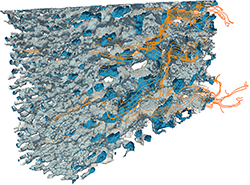How particles and fluids are spread in porous materials

SuMo Biomaterials is a VINN Excellence centre at Chalmers with 35 research groups, seven participating companies and the institute SP Food and Bioscience. The centre is funded equally by Vinnova, the industry and Chalmers. The mathematicians Alexei Heintz and Tobias Gebäck take part with a computer program for simulations of transport processes in different materials.
Some years ago, the then director of SuMo Biomaterials, Magnus Nydén, came and asked if the Division of Mathematics was interested in creating a computer program for transport processes. Alexei Heintz and Tobias Gebäck visited industry people in place to try to figure out what it was that they wanted. They soon found out that not the same language was spoken in industry as in academy. The time scale for when things were wanted was also different and the problems that were to be solved were often very complicated. There was no shortage of data, the amounts were rather on the verge of the computational power of the computers, and it took some time before data that were possible to use were accumulated. But now, there is a useable program available for all in the centre, including the companies.
The program which has been named Gesualdo simulates diffusion and flows in arbitrary porous structures, from a mathematical point of view arbitrary geometries. Alexei gives an example of when a drug tablet is sprayed with different polymeric mixtures so that the substance will spread slower in the body, you then want to know how long time it takes depending on the structure of the mixture. The materials can for example be cellulose based, polymeric, consist of foam or be structured of silica particles, and it is possible to simulate fluids, particles or particles in fluids. The program uses Lattice Boltzmann equations brought from kinetic theory. During the journey, new mathematical problems have arisen and some physical questions have not been known before, as how some processes happen at a microscopic level. Then it has been necessary to create new theory from the basis within the area of homogenization theory.
"Certain issues are located in the borderland between mathematics, theoretical physics and physical chemistry, but are hard to get a grip on from all areas. The applied mathematics sometimes needs more abstract mathematics than what the abstract mathematics itself needs, because you do not know what equations you can apply to the problem. You cannot find the answer in the literature but must redo every step to find that which you are interested in."
Mathematical statistics is also a part of SuMo Biomaterials. Mats Rudemo has been a member of its board from the start, and together with Aila Särkkä and PhD students they have mainly devoted themselves to image analysis. It is about interpreting experimental two- and three dimensional images with a lot of noise in them, and about simulating three dimensional structures. SuMo Biomaterials now has 1.5 years left of the research centre's period of ten years. The continuation of the mathematical statistics part is secured through a grant from SSF.
"There are big plans also for our computer program to continue to develop, so that it can simulate more complicated physical processes with interaction between particles and materials. There is a new postdoc coming in October, it really is way too much work to develop these kind of things on just two persons so it is a welcomed addition. The companies want to continue to use the program also after SuMo Biomaterials has come to an end but the funding is not solved yet. It takes longer time when working together with the industry compared to when researching by oneself and it is a longer way before you reach results, but you also get very much encouragement, the social situation is totally different, so it has been both challenging and fun to work with this," Alexei concludes.
Provided by University of Gothenburg



















